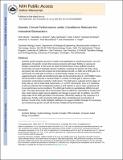Genetic Circuit Performance under Conditions Relevant for Industrial Bioreactors
Author(s)
Moser, Felix; Broers, Nicolette J.; Hartmans, Sybe; Tamsir, Alvin; Kerkman, Richard; Roubos, Johannes A.; Bovenberg, Roel A. L.; Voigt, Christopher A.; ... Show more Show less
DownloadVoigt_Genetic circuit.pdf (1.354Mb)
PUBLISHER_POLICY
Publisher Policy
Article is made available in accordance with the publisher's policy and may be subject to US copyright law. Please refer to the publisher's site for terms of use.
Terms of use
Metadata
Show full item recordAbstract
Synthetic genetic programs promise to enable novel applications in industrial processes. For such applications, the genetic circuits that compose programs will require fidelity in varying and complex environments. In this work, we report the performance of two synthetic circuits in Escherichia coli under industrially relevant conditions, including the selection of media, strain, and growth rate. We test and compare two transcriptional circuits: an AND and a NOR gate. In E. coli DH10B, the AND gate is inactive in minimal media; activity can be rescued by supplementing the media and transferring the gate into the industrial strain E. coli DS68637 where normal function is observed in minimal media. In contrast, the NOR gate is robust to media composition and functions similarly in both strains. The AND gate is evaluated at three stages of early scale-up: 100 mL shake flask experiments, a 1 mL MTP microreactor, and a 10 L bioreactor. A reference plasmid that constitutively produces a GFP reporter is used to make comparisons of circuit performance across conditions. The AND gate function is quantitatively different at each scale. The output deteriorates late in fermentation after the shift from exponential to constant feed rates, which induces rapid resource depletion and changes in growth rate. In addition, one of the output states of the AND gate failed in the bioreactor, effectively making it only responsive to a single input. Finally, cells carrying the AND gate show considerably less accumulation of biomass. Overall, these results highlight challenges and suggest modified strategies for developing and characterizing genetic circuits that function reliably during fermentation.
Date issued
2012-10Department
Massachusetts Institute of Technology. Department of Biological Engineering; Massachusetts Institute of Technology. Synthetic Biology CenterJournal
ACS Synthetic Biology
Publisher
American Chemical Society (ACS)
Citation
Moser, Felix, Nicolette J. Broers, Sybe Hartmans, Alvin Tamsir, Richard Kerkman, Johannes A. Roubos, Roel Bovenberg, and Christopher A. Voigt. “Genetic Circuit Performance Under Conditions Relevant for Industrial Bioreactors.” ACS Synthetic Biology 1, no. 11 (November 16, 2012): 555–564.
Version: Author's final manuscript
ISSN
2161-5063